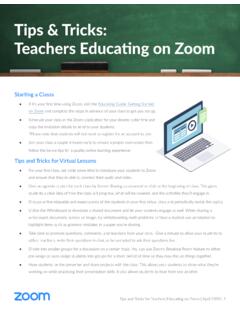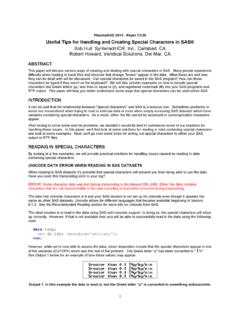Transcription of SMART Goals in Physical and Occupational Therapy: Overview ...
1 SMART Goals in Physical and Occupational Therapy: Overview , Writing tips , and Resources goal is: Components of a SMART goal: S Specific Well defined M Measurable Increase/Decrease .. (measure). A Actionable/Attainable From (baseline). R Relevant To .. (goal). T Time Bound By When .. (end date). Questions to ask when writing SMART Goals : Specific: Ask yourself the questions: who, what, when, where and why? What will the patient or caregiver do? Customize the goal for the patient's issue(s). Avoid vague descriptions. Measurable: How will I measure progress? How will I know it is achieved? Use validated and objective measures. Actionable/Attainable: Is the goal reasonable and achievable? Can this really happen? Set realistic Goals for your patient's Physical , cognitive, social and environmental barriers. Relevant: Why is achieving this goal important? Is the goal meaningful? Avoid Goals that are specific to standardized test items.
2 Establish Goals in partnership with your patient/caregiver. Focus on function Time Bound: When will the goal be achieved? What is the timeframe for achieving the goal? Set a deadline and avoid by discharge . Color-coded formula to assist with writing SMART Goals : Person/Area of Body; Impairment; Impairment Goal; Functional Activity;. Target Performance; Rationale; Target Timeframe/Date Item: Examples: SMART component: Patient, Caregiver or Parent. Person or Area of Body Head, neck, shoulder, trunk, low back, hip, Specific knee, ankle, hands, finger, etc. Strength, ROM, balance, coordination, gait, Impairment Specific swelling, pain, behavior, nutrition intake, etc. ROM degrees, MMT grade, pain VAS level, Impairment Goal Measurable developmental milestone, etc. Rolling, sitting, crawling, standing, cruising, Functional Activity walking, transfers, dressing, eating, bathing, Actionable etc.
3 Assistance level, cues, trials/opportunities, Target Performance Measurable seconds, minutes, hours, day(s), distance, etc. Mobility, play, dressing, ADLs, ensure safety Rationale Relevant in home, etc. Deadline: 2 weeks, 4 weeks, 3 months, 2. Target Timeframe/Date Time bound visits, etc. 2018 eviCore healthcare. All Rights Reserved. This document contains CONFIDENTIAL and PROPRIETARY information. Examples in color-coded formula: Not SMART Goals SMART Goal Examples Improve posture and transfers of sit to stand with Patient will improve postural control by performing minimum assistance 2 out of 3 trials. sit to stand from max to min assistance 2 out of 3. attempts within 15 minutes to aid in transfers by the end of 4 treatment visits. Child will increase strength to creep across family Child will demonstrate increased core strength from room to obtain a toy. 3/5 to 4/5 by creeping 15 feet to obtain toy for play by end of the month.
4 With verbal cues, patient will independently hold Patient will independently sustain a tripod grasp of pencil with a functional digital grasp in 3 out of 4 pencil for handwriting while performing homework opportunities to complete homework assignment. writing assignments in 3 out of 4 opportunities over a 1 month period. Patient will safely swallow thin liquids by cup sip using chin-tuck maneuver in 9/10 trials, as Improve swallow with liquids using chin-tuck. evidenced by no cough post-swallow to increase fluid intake by end of 8 visits. Decrease knee pain to 2/10. Patient's report of anterior knee pain will decrease from 7/10 to 2/10 during prolonged sitting for 4. hours during his work day within 3 weeks. 2018 eviCore healthcare. All Rights Reserved. This document contains CONFIDENTIAL and PROPRIETARY information. Annotated References: Bovend'Eerdt, T., Botell, R., & Wade, D.
5 (2010). Writing SMART rehabilitation Goals and achieving goal attainment scaling: A practical guide (vol 23, pg 352, 2009). Clinical Rehabilitation, 24(4), 382-382. The success of goal setting and goal attainment scaling depends on the formulation of the Goals . The method described here is a useful tool to standardize the writing of Goals in rehabilitation. It saves time and simplifies the construction of Goals that are sufficiently specific to be measurable.. Bowman, J., Mogensen, L., Marsland, E., & Lannin, N. (2015). The development, content validity and inter rater reliability of the SMART Goal evaluation method: A standardised method for evaluating clinical Goals . Australian Occupational Therapy Journal, 62(6), 420-427. The method serves a dual purpose as an evaluative audit tool and a structure to assist Occupational therapists and other allied health clinicians write Goals in accordance with the SMART .
6 Acronym . Hersh, D., Worrall, L., Howe, T., Sherratt, S., & Davidson, B. (2012). SMARTER goal setting in aphasia rehabilitation. Aphasiology, 26(2), 220-233. While this paper discusses SMARTER goal setting within aphasia rehabilitation, a particularly challenging context for the implementation of collaborative practice, it may be applicable to rehabilitation more broadly. Given that person centred goal setting within stroke rehabilitation remains infrequent, we suggest that there is an urgent need to raise awareness of its importance and challenge current practice. The SMARTER framework provides a useful structure to support collaborative goal setting.. Leistra, E., Streppel, M. T., Klamer, J., Tump, A. C., & Weijs, P. J. (2015). SUN-PP190: Effect of SMART goal setting and nutritional assessment on treatment compliance in primary care dietetic treatment. Clinical Nutrition, 34, S94-S94.
7 (15)30341-1. Setting SMART treatment Goals and performing Nutritional Assessment during first dietetic consultations are related to higher treatment compliance in primary care setting.. Marsland, E., & Bowman, J. (2010). An interactive education session and follow-up support as a strategy to improve clinicians' goal-writing skills: A randomized controlled trial. Journal of Evaluation in Clinical Practice, 16(1), 3-13. The literature indicates that Goals should include the specified SMART domains to ensure collaborative and client centred services that are outcomes based, cost effective and time . efficient. These results provide preliminary evidence of the areas of difficulty clinicians are experiencing when writing clinical Goals .. 2018 eviCore healthcare. All Rights Reserved. This document contains CONFIDENTIAL and PROPRIETARY information. Plan of Care and SMART Goal Links: 53EC 4E46.
8 8E1D 5EF129CB5E2A/Goal Writing_5 2018 eviCore healthcare. All Rights Reserved. This document contains CONFIDENTIAL and PROPRIETARY information.






